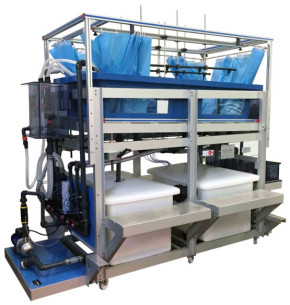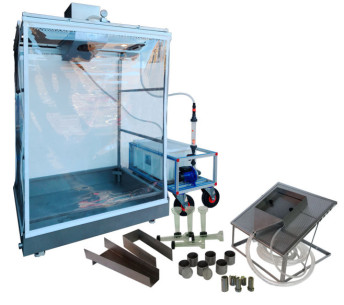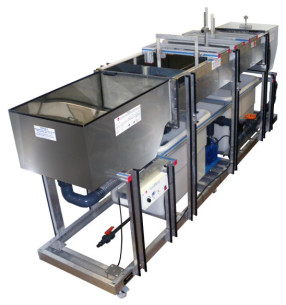EFAS Оборудование для исследования подземного водного потока
ИННОВАЦИОННЫЕ СИСТЕМЫ
The Ground Water Flow Unit, "EFAS", allows to demonstrate the hydrological principles of groundwater flow and the applications of these to different engineering constructions. It allows the investigation of ground water flows, the drainage processes and the effect of the permeability.
ЛАБОРАТОРИИ
НОВОСТИ ПО ТЕМЕ
ОБЩЕЕ ОПИСАНИЕ
The Ground Water Flow Unit, "EFAS", is composed of a test tank that will be filled with fine grave or sand to construct to develop different models. The entry of water into the tank is done through two inlets, each of them located at each end. The flow of each water inlet is controlled by a membrane valve, which is easily accessible for the user. Inlets end inside the tank in a diffuser shape to affect the least possible the created model.
In the base of the test tank there are two wells simmetrically located. The wells outlets, located at the bottom part of the tank, have a membrane valve, that allows the regulation of the outletflows. Well have a spillway in their upper partto avoid floods.
The unit includes nineteen tappings in the base of the test tank, configured in cross shape . Pressure of the nineteen tappings can be seen in two manometers panels. The tappings have a sediments picking system to avoid them to reach the measuring elements. Under each tapping there is a plug which has to be removed regularly to extract the sand accumulated in it.
This unit is supplied with three accessories that make it easy the construction of the different models object of study:
- Model for a lake construction.
- Model for an excavation construction.
- Model for a confined aquifer construction.
In addition to the demonstrations and exercises proposed (see "Exercises and Practical Possibilities" section), instructors andstudents may contrutfurther model situations for study.
УПРАЖНЕНИЯ И ПРИМЕРЫ С ИНСТРУКЦИЯМИ
РУКОВОДСТВО ПО ПРАКТИЧЕСКИМ УПРАЖНЕНИЯМ ВКЛЮЧЕНО В РУКОВОДСТВО ПОЛЬЗОВАТЕЛЯ
- Demonstration of hydraulic gradients in ground water flow, including the effect of permeability.
- Investigation of hydraulic gradients for different models built on the test tank.
- Determination of the ground water level between inlet and outlet.
- Demonstration of the Darcy’s Law.
- Study of the cone of depression for a well in a confined aquifer.
- Study of the cone of depression for a well in a free aquifer.
- Study of the cone of depression cone for two wells.
- Experiment to obtain hydraulic gradients for a model with two wells. Compare it with the result of only one well by the superposition method.
- Draining of or lake model.
- De-watering of an excavation model under freatic level.
- De-watering of an excavation model using two wells.
- Interaction of cones of depression by two adjoining wells.
- Draw-down curves for one well and two wells systems.
- Comparison of different profiles, combinations.
- How to fill the manometer tubes.
ДОПОЛНИТЕЛЬНОЕ ОБОРУДОВАНИЕ
Оборудование для гидрологических систем, имитатор дождя и систем орошения (2X1 м), управляемое ПК
Оборудование для гидрологических систем, имитатор дождя и систем орошения (2X1 м)
Оборудование для гидрологических исследований, управляемое ПК
Оборудование для гидрологических исследований
Оборудование для построения гидрограмм осадков
Моделлер дождя для исследований эрозии почвы, управляемый с компьютера (ПК)
Моделлер дождя для исследований эрозии почвы
Моделлер потока рек
Оборудование для визуализации подвижного слоя и потока (рабочая секция: 2000X610 мм)
Оборудование для визуализации подвижного слоя и потока (рабочая секция: 4000X610 мм)
Открытый канал осаждения
КАЧЕСТВО

ПОСЛЕПРОДАЖНОЕ ОБСЛУЖИВАНИЕ

 Настройки cookie
Настройки cookie


















